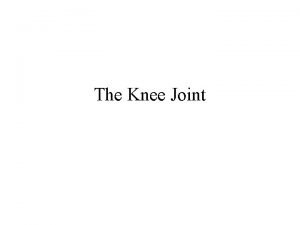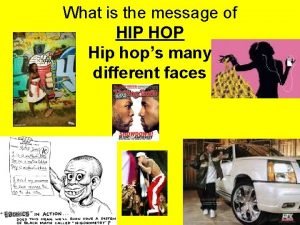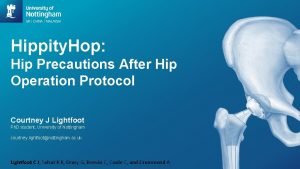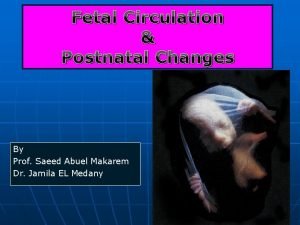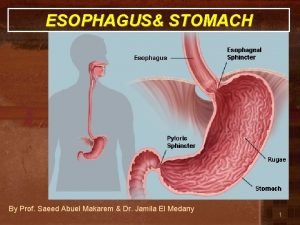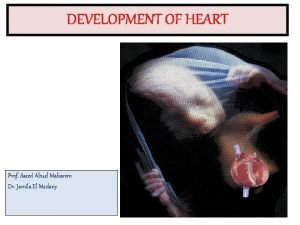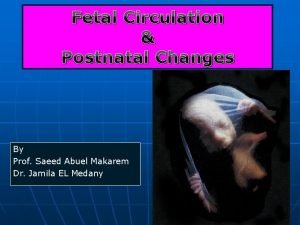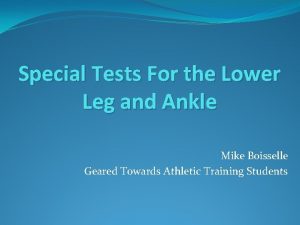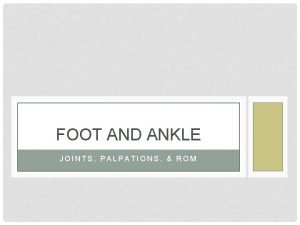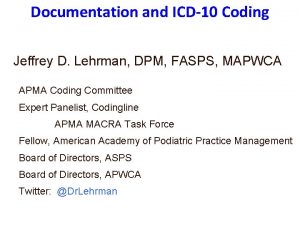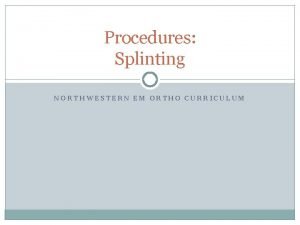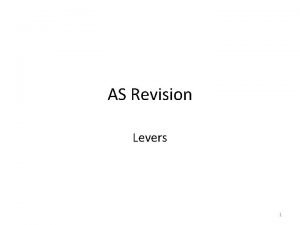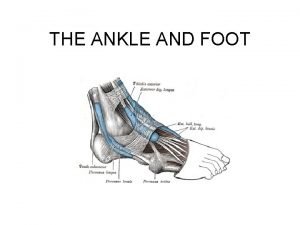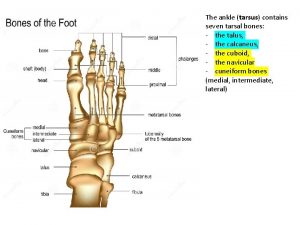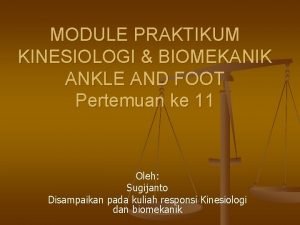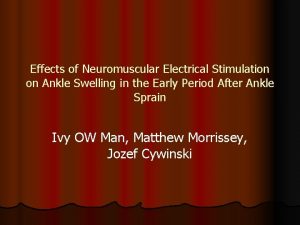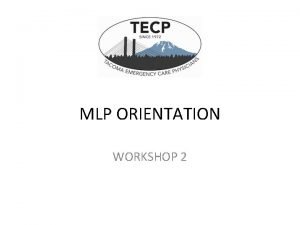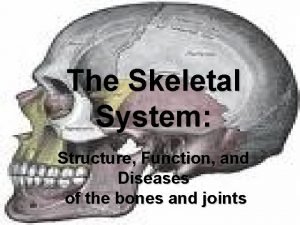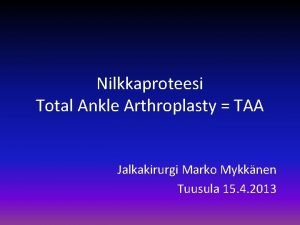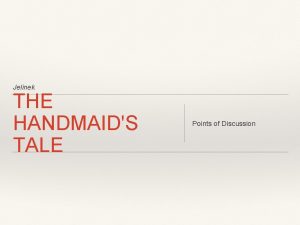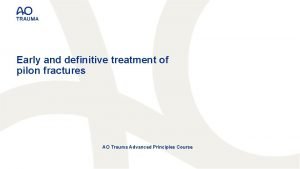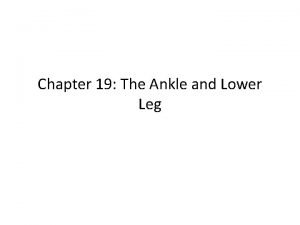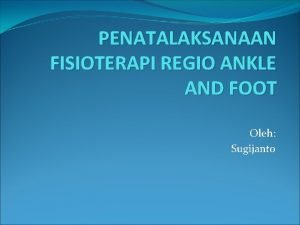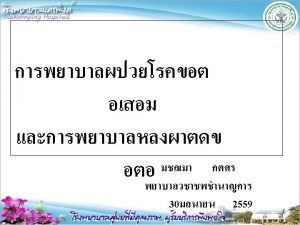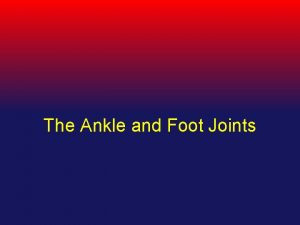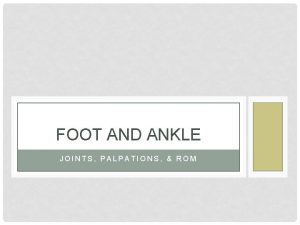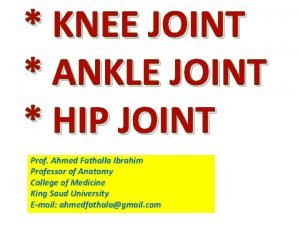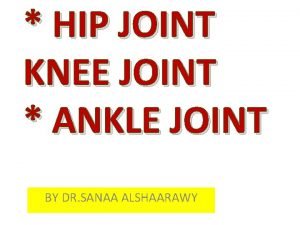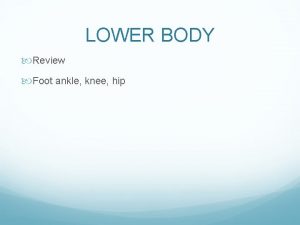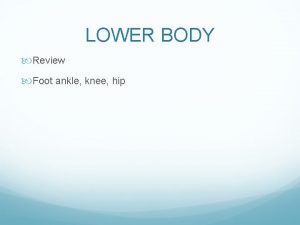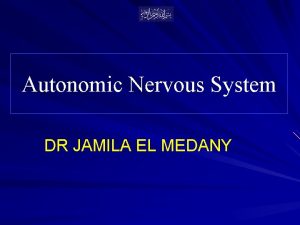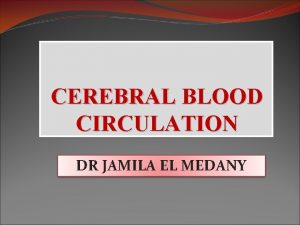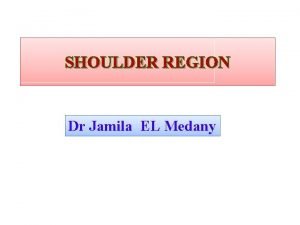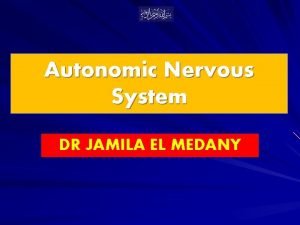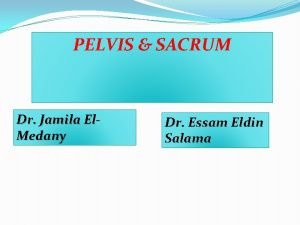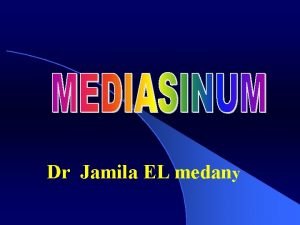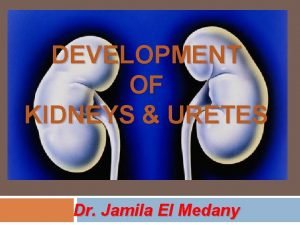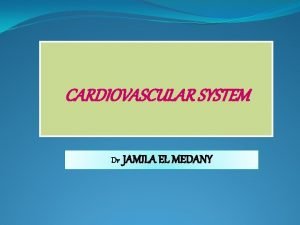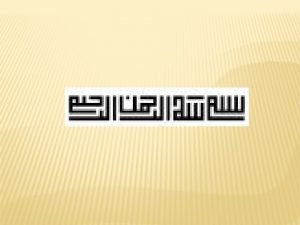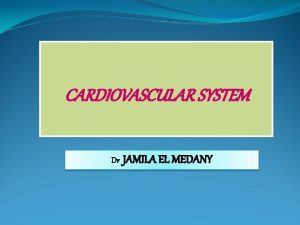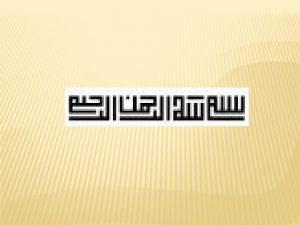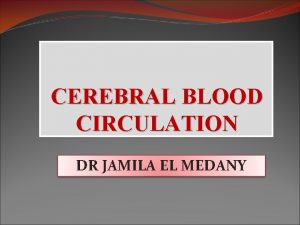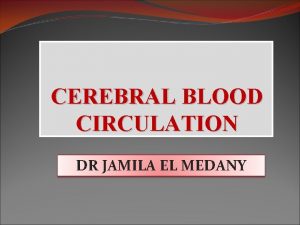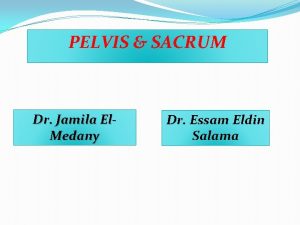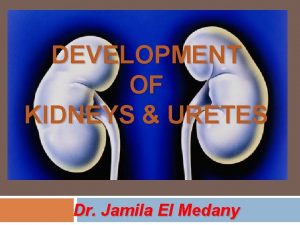Hip Knee Ankle Joints Dr Jamila EL Medany





























- Slides: 29

Hip, Knee & Ankle Joints Dr Jamila EL Medany

OBJECTIVES At the end of the lecture, students should be able to: § List the type & articular surfaces of the hip, knee and ankle joints. § Describe the capsule and ligaments of the hip, knee and ankle joints. § Describe movements of hip, knee and ankle joints and list the muscles involved in these movements. § List important bursae in relation to knee joint. § Apply Hilton’s law about nerve supply of joints.

HIP JOINT § TYPE: • Synovial, Synovial Ball & Socket joint. § ARTICULAR SURFACES: • Acetabulum of hip (pelvic) bone • Head of femur § Acetabular labrum: § C-shaped fibro-cartilaginous collar attached to margins of acetabulum, increases its depth for better retaining of head of femur. Acetabular labrum

Ligaments: (3) Extracapsular Inte rtroc hant eric line Iliofemoral ligament: • Y-shaped • Located anterior to joint • limits extension Pubofemoral ligament: • Located antero-inferior to joint • limits abduction & lateral rotation Ischiofemoral ligament: • Located posterior to joint • limits medial rotation

(3) Intracapsular Transverse acetabular ligament: converts acetabular notch into foramen through which pass acetabular vessels Ligament of femoral head: carries vessels to head of femur §Acetabular labrum

Movements § Flexion: Iliopsoas (mainly), sartorius, pectineus, rectus femoris. § Extension: Hamstrings (mainly), gluteus maximus (powerful extensor). § Abduction: Gluteus medius & minimus, sartorius. § Adduction: Adductors, gracilis. § Medial rotation: Gluteus medius & minimus. § Lateral rotation: Gluteus maximus, quadratus femoris, piriformis, obturator externus & internus.

BLOOD SUPPLY • The main arterial supply is from branches of the circumflex femoral arteries (especially the medial). • The blood passes to the joint through : • (1) Retinacular fibers of the neck. • (2) Ligament of the head of the femur.

• Damage of the retinacular fibers as in fracture neck of the femur can results in • A vascular necrosis of the head of the femur. • Fracture neck of the femur is common after age of (60) years especially in women because of Osteoporosis.

STABILITY OF THE JOINT • The hip joint is one of the most stable joints of the body because of : • (1) The Head of the femur fits very accurately in the acetabulum due to the following: • A. The acetabulum is very deep and its depth is increased by the labrum acetabulare. • B. The labrum acetabulare forms a firm grip on the head of the femur. • C. The atmospheric pressure resists separation between the head of the femur and the acetabulum. • (2) The three strong Extrinsic ligaments. • (3) The surrounding strong Muscles.

DISLOCATION OF HIP JOINT • CONGENITAL • More common in girls and associated with inability to adduct the thigh. • The upper lip of the acetabulum fails to develop adequately. • The head of the femur rides up out of the acetabulum onto the gluteal surface of the ileum.

• TRAUMATIC: • It is common in motor vehicle accidents when the thigh is flexed and adducted. • The dislocated head is displaced posteriorly to lie on the posterior surface of the ileum. • In posterior dislocation, the sciatic nerve is liable to be injured.

KNEE JOINT • FUNCTIONS: • 1. Weight bearing. • 2. Essential for daily activities: standing walking & climbing stairs. • 3. The main joint responsible for sports: running, jumping , kicking etc.

Type & Articular Surfaces Knee joint is formed of: §Three bones. §Three articulations. §Femoro-Tibial articulation: between the 2 femoral condyles & upper surfaces of the 2 tibial condyles §Type: synovial, modified hinge §Femoro-Patellar articulation: between posterior surface of patella & patellar surface of femur §Type: synovial, plane.

Capsule §Is Deficient Anteriorly & replaced by: quadriceps femoris tendon, patella & ligamentum patellae. §Possesses 2 openings: openings one for popliteus tendon & one for communication with suprapatellar bursa.

Ligaments: (4) Extracapsular 1. Ligamentum patellae (patellar ligament): from patella to tibial tuberosity. 2. Medial (tibial) collateral ligament: from medial epicondyle of femur to upper part of medial surface of tibia (firmly attached to medial meniscus). 3. Lateral (fibular) collateral ligament: from lateral epicondyle of femur to head of fibula 4. Oblique popliteal ligament: extension of semimembranosus tendon.

INTRA Capsular Structures : Menisci § They are 2 C-shaped plates of fibro -cartilage attached by anterior & posterior horns, to the articular surface of tibia. FUNCTION: § They deepen articular surfaces of tibial condyles. § They serve as cushions between tibia & femur. § Lateral Meniscus: § Small & Circular § Its outer border is separated from lateral collateral ligament by popliteal tendon. § Medial Meniscus: § Large & Oval. val § Its outer border is (firmly attached to the capsule & medial collateral ligament. § medial meniscus is less mobile & more liable to be injured.

CRUCIATE Ligaments • • • Two in number, situated in the middle of the joint. They are called Cruciate because they cross each other Have received the names Anterior and Posterior, from the position of their attachments to the tibia. Anterior cruciate ligament: • Extends from anterior part of intercondylar area of tibia to posterior part of lateral condyle of femur. Posterior cruciate ligament: • Extends from posterior part of intercondylar area of tibia to anterior part of medial condyle of femur.

Functions of Cruciate Ligaments • Anterior ligament: • Prevents posterior displacement of the femur on the tibia and the tibia from being pulled anteriorly when the knee joint is extended. • It is taught in Hyper extension. • Posterior ligament: • prevents anterior displacement of the femur on the tibia and the tibia from being pulled posteriorly when the knee joint is flexed. • It is taught in Hyper flexion.

Bursae Related to Knee joint § Suprapatellar bursa: between femur & quadriceps tendon, communicates with synovial membrane of knee joint (Clinical importance? ) § Prepatellar bursa: between patella & skin. § Deep infrapatellar bursa: between tibia & ligamentum patella. § Subcutaneous infrapatellar bursa: between tibial tuberosity & skin. § Popliteal bursa between popliteus tendon & capsule, communicates with synovial membrane of knee joint.

MOVEMENTS § FLEXION: 1. Mainly by hamstring muscles: biceps femoris , semitendinosus & semimembranosus. 2. Assisted by sartorius , gracilis & popliteus. § EXTENSION: Quadriceps femoris. § ACTIVE ROTATION (PERFORMED WHEN KNEE IS FLEXED): A) MEDIAL ROTATION: 1. Mainly by semitendinosus & semimembranosus. 2. Assisted by sartorius & gracilis. B) LATERAL ROTATION: Biceps femoris.

INACTIVE (DEPENDANT) ROTATION • A) LOCKING OF KNEE: • The joint assumes the position of full extension. • It becomes a rigid structure. • The menisci are compressed between the tibial and femoral condyles. • Results mainly by tension of anterior cruciate ligament. • Tightening of all the major ligaments. • The femur is medially rotated on the tibia (Lateral rotation of tibia).

popliteus • B) UNLOCKING OF KNEE: • Medial rotation of tibia (Lateral rotation of femur), at the beginning of flexion • Performed by Popliteus to relax ligaments & allow easy flexion.

STABILITY OF THE JOINT • 1. Muscles : • QUADRICEPS particularly the inferior fibers of the Vasti lateralis and medialis. • Many sport injuries can be preventable through appropriate training and conditioning of the muscle. • 2. Ligaments : • The knee joint can function well following a ligamentous strain if the quadriceps is intact.

Skeleton of Foot

ANKLE JOINT TYPE: synovial, synovial hinge joint. ARTICULAR SURFACES: UPPER A socket formed by: Lateral malleolus, the lower end of tibia & medial malleolus. LOWER: Body of talus.

Ligaments MEDIAL (DELTOID) LIGAMENT: §A strong triangular ligament. §Apex: attached to medial malleolus. §Base: subdivided into 4 parts: 1. Anterior tibiotalar part. 2. Tibionavicular part. 3. Tibiocalcaneal part. 4. Posterior tibiotalar part. LATERAL LIGAMENT: §Composed of 3 separate ligaments §Anterior talofibular ligament. §Calcaneofibular ligament. §Posterior talofibular ligament.

Movements DORSIFLEXION: § Performed by muscles of anterior compartment of leg (tibialis anterior, extensor hallucis longus, extensor digitorum longus & peroneus tertius). PLANTERFLEXION: § Initiated by soleus. § Maintained by gastrocnemius. § Assisted by other muscles in posterior compartment of leg (tibialis posterior, flexor digitorum longus & flexor hallucis longus) + muscles of lateral compartment of leg (peroneus longus & peroneus brevis) q INVERSION & EVERSION MOVEMENTS occur at the talocalcaneo-navicular (subtalar ) joint (Not at ankle joint).

Nerve Supply of all JOINTS HILTON’S LAW: LAW “The joint is supplied by branches from nerves supplying muscles acting on it”.

BEST LUCK
 Knee flexors
Knee flexors Hip hop hip to the hippity
Hip hop hip to the hippity The hip to the hop to the hippity hop
The hip to the hop to the hippity hop Jamila piracci
Jamila piracci Jamila edwards
Jamila edwards Arabic adjectives
Arabic adjectives Ligamentum arteriosum ligation
Ligamentum arteriosum ligation Cardiac orifice
Cardiac orifice Endocardial cushion
Endocardial cushion Medany el makarem
Medany el makarem Thompson test
Thompson test Ankle pull carry
Ankle pull carry Rom toes
Rom toes Ankle sprain icd 9
Ankle sprain icd 9 Inferolateral knee injection
Inferolateral knee injection Buddy splint indication
Buddy splint indication Ober's test
Ober's test Lever classes
Lever classes Muscles in plantar flexion
Muscles in plantar flexion Sustentaculum tali
Sustentaculum tali Articulatio talo tarsalis
Articulatio talo tarsalis Biomekanik ankle
Biomekanik ankle Electronic muscle stimulation ankle sprain
Electronic muscle stimulation ankle sprain Ulnar gutter slab
Ulnar gutter slab Twisted ankle
Twisted ankle Ankyloitunut
Ankyloitunut Offred tattoo ankle
Offred tattoo ankle Chaput fragment ankle
Chaput fragment ankle Chapter 19 worksheet the ankle and lower leg
Chapter 19 worksheet the ankle and lower leg Tes spesifik plantar fasciitis
Tes spesifik plantar fasciitis
